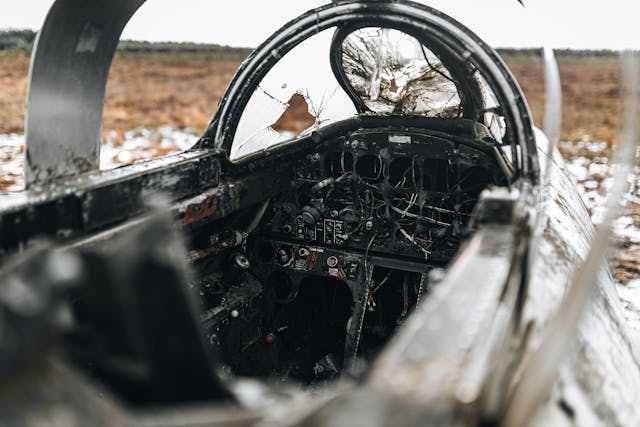Inside the Silverhawk Aviation emergency landing in Rochester, how it unfolded, what went wrong, and the remarkable recovery.
On a typical clear-sky day over Minnesota, the hum of engines aboard a Silverhawk Aviation charter flight was steady and familiar. The aircraft, sleek, maintained with military-level precision, and guided by a highly trained flight crew, was en route, carrying passengers whose lives were about to be thrust into a narrative of high-stakes decision-making and split-second precision.
No one ever expects to be part of an emergency landing. It’s the kind of thing you see in movies or read about in newspapers with other people’s names. But on that particular day, the city of Rochester bore witness to a scene that walked the tightrope between disaster and miracle.
What You'll Discover:
The Moment Things Went Sideways
It didn’t begin with a bang or a scream. In fact, the first sign that something was off came in the form of a flicker, an instrument panel that blinked a little too long, a sound that didn’t belong.
Pilots are trained for every imaginable scenario, but training only gets you so far. It’s grit, experience, and mental clarity that define what happens next. And for Silverhawk’s pilots, that moment had arrived.
What Exactly Went Wrong?
Preliminary information points to a pressurization system malfunction, a seemingly small hiccup in a highly complex machine. But even minor faults in aviation can ripple into major decisions.
Pressurization isn’t just about comfort. At cruising altitude, without it, oxygen levels drop dangerously low. The cockpit crew noticed cabin pressure irregularities, levels fluctuating outside of standard ranges. That alone could have led to hypoxia, a condition where lack of oxygen affects decision-making, reaction times, and even consciousness.
The Silverhawk team responded within seconds.
The Emergency Call to Rochester
Why Rochester?
Rochester International Airport (RST) isn’t the largest nor the busiest airport in the region, but it boasts a critical advantage: a reputation for fast emergency responsiveness, a well-equipped airfield, and unobstructed approach paths, the holy trinity when you’re in the sky looking for a place to land in a hurry.
Mayday. Mayday. Controlled Descent.
The emergency call was placed. Not a panicked scream, but a composed, technically precise declaration: “This is Silverhawk 401 requesting immediate priority landing due to suspected pressurization system failure. Rochester is nearest. Preparing descent.”
Air traffic control jumped into action. Nearby flights were rerouted, emergency services were placed on standby, and the runway was cleared.
In the cabin, passengers were likely unaware of the technical jargon flying back and forth, but they could feel something had changed. Descent began faster than usual, and cabin crew followed emergency descent procedures. Oxygen masks deployed, not out of drama, but out of protocol.
Who Is Silverhawk Aviation, Really?
To understand the gravity of this event, you have to know who was behind the controls.
Silverhawk Aviation isn’t some back-lot charter company. They are a renowned operator based out of Lincoln, Nebraska, known for their executive charters, aircraft management, and top-tier maintenance standards. Their fleet includes Citation jets, meticulously maintained and updated to comply with all FAA and international aviation standards.
Their pilots aren’t just certified, they’re elite. Veterans of thousands of flight hours, recurrent training cycles, and simulation drills that recreate scenarios exactly like the one they found themselves in over Rochester.
This wasn’t luck. This was preparation meeting its most brutal exam.
Passenger Accounts: A Mix of Tension and Trust
One passenger later shared that the entire descent felt “controlled but urgent.” Another recalled that the flight attendant never wavered, calmly explaining procedures while ensuring passengers stayed buckled and reassured.
That’s the hallmark of an experienced crew, they make fear manageable. No panic. Just process.
While some passengers clutched armrests or whispered prayers, others were quietly impressed by the professionalism flowing through the cabin.
The Landing: A Symphony of Skill
No crash. No fireballs. No overdramatic scene.
Instead, what happened was one of the most precise emergency landings RST has seen in years.
The aircraft touched down smoothly, flaps extended, gear locked, and crew communicating every microsecond with the control tower. Emergency crews flanked the runway, ready for fire suppression, medical assistance, or evacuation.
They weren’t needed.
The pilots taxied the plane safely off the runway. Paramedics did routine checks. Nobody was injured. Not a scratch. It was, in the world of aviation, the best-case outcome from a worst-case trigger.
What Happens After a Safe Landing?
The work wasn’t over.
Aircraft Inspection & FAA Protocol
After grounding the aircraft, aviation technicians inspected the pressurization system and other affected components. FAA officials, as per standard post-emergency procedures, launched a full investigation.
While a pressurization issue may sound minor to the untrained ear, it’s a serious matter. Every component, valves, seals, sensors, was examined.
Initial findings pointed to a sensor anomaly that fed false data into the system, triggering automated countermeasures. A situation like that can cascade quickly, but the Silverhawk crew had halted that chain reaction.
Psychological Debriefs for Passengers & Crew
Though there were no physical injuries, emotional aftermath is real. Silverhawk offered counseling sessions to affected passengers and crew. It wasn’t just a gesture, it’s part of their protocol.
Trauma can live in the shadows of survival. And acknowledging it is part of real aviation safety culture.
A Wider Look: How Common Are Emergency Landings?
The idea of a plane making an emergency landing sparks fear, but context matters.
According to FAA data:
- There are over 45,000 daily flights in the U.S.
- Emergency landings occur in less than 0.002% of those.
- Most emergencies are preventative or precautionary, not catastrophic.
What makes the Silverhawk incident exceptional isn’t that it happened, but how well it was handled.
Rochester’s Role: More Than Just a Runway
Let’s not forget the unsung heroes here.
Rochester International Airport is staffed 24/7, with a professional emergency response unit that drills regularly for such events. The coordination between the Silverhawk pilots and Rochester ATC was textbook, and the airport’s quick adaptation saved precious minutes, which in aviation can mean everything.
Local fire departments, medical teams, and security personnel all responded without hesitation. That kind of community-level readiness doesn’t get headlines, but it’s the bedrock of real aviation safety.
What This Incident Teaches Us
Safety Isn’t Just Technology, It’s Human
Silverhawk had advanced systems. But those can fail. What doesn’t fail? The trained human being in the cockpit who doesn’t freeze, doesn’t fumble, and doesn’t fold under pressure.
The Invisible Network That Keeps Us Safe
From the moment that first sensor acted up to the final touchdown in Rochester, a massive, invisible network of aviation protocols kicked into action. Pilots, air traffic controllers, ground crews, emergency responders, they formed a living organism of safety.
Trust Built Over Years, Tested in Seconds
Silverhawk Aviation has cultivated trust through years of spotless service and safety compliance. And on that day, they didn’t just meet expectations, they exceeded them.
Key Takings
- Fast Thinking Saves Lives: The crew’s immediate, level-headed response turned a dangerous situation into a textbook save.
- Rochester Was the Right Choice: The airport’s readiness, quick response, and infrastructure made it the ideal emergency landing location.
- Silverhawk Aviation Proved Its Metal: Beyond brand reputation, their commitment to training and safety protocols truly showed.
- Technology Isn’t Infallible: It was a sensor anomaly, small, but significant. Human oversight still matters deeply.
- Passenger Safety Includes Psychology: Post-landing support acknowledged the emotional impact, not just physical safety.
- Emergency Landings Aren’t Always Disasters: With the right systems and people in place, they can end without injury or incident.
- Every Flight Relies on Hundreds Behind the Scenes: From the moment the emergency began to wheels down, it took a network of professionals to make the safe landing possible.





